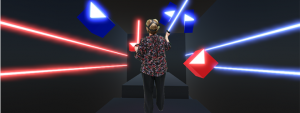Stuart Embleton knows the value of a consistent exercise routine. It was the first thing his doctors prescribed when they found a blocked artery in his heart.
“I haven’t had major heart surgery,” Embleton notes gratefully, but adds that this incident with his health motivated him to lead a more active lifestyle. His quest led him to the Cardiac Athletic Society of Edmonton (CASE), where he was offered the opportunity to join a trial for a gamified exercise platform called Virtual Gym.
Thanks to Virtual Gym, Embleton and older adults like him will soon have access to personalized exercise routines that they can do at home, while being supervised by their physiotherapists.
“The original question we had when developing Virtual Gym, was how we could use technology to create personalized exercises that would be interesting and accessible to seniors,” says Eleni Stroulia, Project Lead. Stroulia and her research partner, Victor Fernandez created the platform with support from the Centre for Aging + Brain Health Innovation’s (CABHI) Spark Program. Spark aides the development of early-stage innovations in the field of aging and brain health.
An Exercise Regimen with a Twist

Older adult playing Virtual Gym game, Rhythm Saber.
To make the exercises in Virtual Gym appealing to older adults, Stroulia and Fernandez merged therapist-guided routines with interactive activities powered by virtual reality (VR).
The games immerse users in virtual worlds featuring scenes like underwater caves and mountainous landscapes, where they are challenged to complete a task such as “bursting bubbles” or “scaling a mountain side.”
“Wrapping the activities in a game motivates people to do them,” says Stroulia. “With the gamified system, you get people to exercise and enjoy it.”
This is true for Stuart, who says the VR component is a significant draw for him.
“It’s fun for me. Instead of sitting on a couch lifting weights, I’m slashing cubes with light sabers,” he says of one of the virtual games.
Co-designing with Older Adults
With CABHI’s support, Stroulia and Fernandez were able to test and validate the project in a real-world setting at CASE. They received valuable feedback from older adults on ways to make the platform more user-friendly.
“One of the things we learned was that people don’t want an activity they are being corrected on all the time,” says Fernandez. “The important part is that they like it so much that they forget they’re exercising.”
Yet, meeting the demand to create rehabilitative program that was engaging, but not overly prescriptive, presented a challenge for the pair.
To address this issue, Fernandez amended the game to repeat levels or combos the user did not complete or completed incorrectly. This way, users could still receive the rehabilitative benefits of the exercise without feeling pressured to get it right on the first try.
CABHI’s Spark-U Helps Innovators Plan for Next Stage of the Virtual Gym

This simulated archery game requires users to make coordinated movements to hold the bow and arrow.
Since being accepted into the Spark Program, Fernandez and Stroulia have received additional support from CABHI’s Spark-U initiative. Spark-U is a learning collaborative for innovators, designed to support their journey from innovation development to planning for sustainability.
For Fernandez, Spark-U has already played a significant role in the development of Virtual Gym. It will continue to do so as the platform is refined and prepared for use by a broader group of older adults.
“The Spark-U lectures tell you how to protect your copyright, when to protect your copyright, and what things you should be careful of when you deploy these devices to the public.”
Thanks to the knowledge gained from Spark-U, Fernandez and Stroulia feel confident about taking their innovation to the next level. A recent AGE-WELL Emerging Entrepreneur Award in Technology and Aging, will also help the team acquire hardware and increase older adults’ access to the platform.
“The vision is to have a catalogue of exercises. We’ll also be collecting feedback to share with the physicians who prescribed the exercise, so that they can see what improvements are being made,” Fernandez adds.
Stuart has no doubt the platform will accomplish this vision and more. “I’m convinced Virtual Gym will enhance my physical activities. I’m enthusiastic about its potential, and confident that Victor and Eleni will get the job done.”


